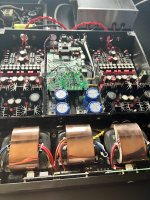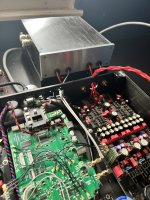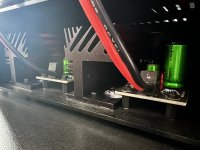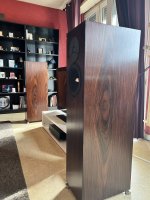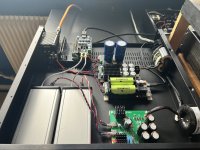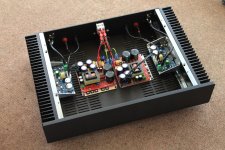Well your comment about implementation is clearly true in relation to just about any technology you care to mention. What I’m interested in knowing is whether, given an at least satisfactory implementation in each case, an O core might be expected to be a better overall solution for hi fi than other types of trafo.
"The feeding source is important"
I have Andrea's FIFO with DRIXO 5Mhz and 6 Mhz in my DAC,but I decided to take care of my source anyway,So I added a Q7-SinePi-DRIXO 11Mhz/12Mhz-HdmiPiPro to the Raspi4,all is much more accurate,a big difference,in my opinion the FIFO is interesting to take advantage of good clocks in our case the DRIXOs of andrea,but not necessarily to isolate the source.
To feed the DRIXOs i have obtained excellent results with Salas SSLV1.3 UltraBiB shunt regulator,much better than with the TWRPS-UGL,mainly in the bass frequency,
I use a O Core transformer,sebbyp I advise you to take an interest in O Core transformer,I guess this contributes a lot to the good result I have with the UltraBiB.
http://jamestransformer.com/en/transformer/O_core_transformer.html
Sounds like you have a fantastic system! Thank you for taking the time to feedback on SSLV vs TWRPS-UGL, given my past experience, I assumed it would respond well to good PS's but I went straight to LT3045's and haven't been motivated to experiment.
Did you upgrade from the Q3 or HDMIpi? Notice any differences, worthwhile?
What is the rest of the system?
Thank you both for mentioning these O-Core transformers. I actually came across James Transformers and the O-core's, when looking at an amplifier built by someone in the UK who used his transformers for output's (Not O-Core and a D3A driving a 2A3). I did a quick google, but there wasn't any subjective reviews but the technical benefits were clear. Left it at that.I second the recommendation for o core transformers.
I changed to toroids on my DDAC to o core on both digital and analog supplies.
First changing the analog and listening then the digital.
There was significant audible improvement at each step.
Much more than I would have believed before doing this.
I'm motivated, I'll order one for my array and try the Salas shunt too.
Studley,
Looks like O-core is kind of a mix between R-core and Torroid. Turns out torroids tend to have problems with sensitivity to small DC offsets of AC line voltage which arise due to distortions of the line voltage waveform caused by some loads. I would expect O-core to have the same potential for such problems if not carefully managed. What can be done with torroids to improve performance in that regard is to make them deeper, kind of like two torroids stacked on top of each other to make one thick-in-depth core. The reasons for DC sensitivity are easily predictable from basic transformer design equations. Making the core cross-sectional area bigger by increasing depth is one possible solution. OTOH, a round cross-section torroid such as O-core will have to mitigate the issue in some other way, or else the user will have to be careful about DC offsets at the transformer primary. That's my sort of general concern which I give without knowing more about O-core transformer specifications, lamination thickness, material selection, etc.
Mark
Looks like O-core is kind of a mix between R-core and Torroid. Turns out torroids tend to have problems with sensitivity to small DC offsets of AC line voltage which arise due to distortions of the line voltage waveform caused by some loads. I would expect O-core to have the same potential for such problems if not carefully managed. What can be done with torroids to improve performance in that regard is to make them deeper, kind of like two torroids stacked on top of each other to make one thick-in-depth core. The reasons for DC sensitivity are easily predictable from basic transformer design equations. Making the core cross-sectional area bigger by increasing depth is one possible solution. OTOH, a round cross-section torroid such as O-core will have to mitigate the issue in some other way, or else the user will have to be careful about DC offsets at the transformer primary. That's my sort of general concern which I give without knowing more about O-core transformer specifications, lamination thickness, material selection, etc.
Mark
Hey Mark, this is definitely an issue for a toroid transformer, but easily dealt with. Here is an example solution: https://sklep.toroidy.pl/en_US/p/DC-Blocker-Mains-DC-Filter/570 or you can use a Schaffner filter on the IEC.
I think the bigger issue is that they have a wider frequency response, than say an EI core, which allows more conducted RF noise through. This is from a comment from a conversation from a friend of mine a few weeks ago on this topic:
When used as power transformers toroids are more efficient than EI ( C core) and have a much lower radiated magnetic field but also
have a lower leakage inductance which means they have a wider frequency response. The R-core is somewhere
in between. It was designed to make manufacture of a toroid shape easier but a by product is the separation of the primary
and secondary coils which reduces inter coil capacitance coupling similar to that of an EI.
The lower radiated magnetic field of the toroid helps with reduction of low frequency noise such as hum but the wider frequency
response allows more conducted RF noise through ( not 50/60Hz by the way).
So with an EI the main problem is orientating the transformers to reduce low frequency radiated magnetic noise pick up but with the toroid
its dealing with the conducted RF noise. Any sonic differences will be due to how well these problems are attended to in any particular application.
As the R core has a similar core shape to the toroids they have similar low radiated magnetic field but they also can have
separate primary and secondary coils which can provide more leakage inductance so limiting the HF response. In short possibly
the best of both worlds. This probably accounts for the current popularity of R cores.
I hope this helps, but I believe it all comes down to implementation. Verdict's out on O-cores and I'll be asking him for his opinion!
I think the bigger issue is that they have a wider frequency response, than say an EI core, which allows more conducted RF noise through. This is from a comment from a conversation from a friend of mine a few weeks ago on this topic:
When used as power transformers toroids are more efficient than EI ( C core) and have a much lower radiated magnetic field but also
have a lower leakage inductance which means they have a wider frequency response. The R-core is somewhere
in between. It was designed to make manufacture of a toroid shape easier but a by product is the separation of the primary
and secondary coils which reduces inter coil capacitance coupling similar to that of an EI.
The lower radiated magnetic field of the toroid helps with reduction of low frequency noise such as hum but the wider frequency
response allows more conducted RF noise through ( not 50/60Hz by the way).
So with an EI the main problem is orientating the transformers to reduce low frequency radiated magnetic noise pick up but with the toroid
its dealing with the conducted RF noise. Any sonic differences will be due to how well these problems are attended to in any particular application.
As the R core has a similar core shape to the toroids they have similar low radiated magnetic field but they also can have
separate primary and secondary coils which can provide more leakage inductance so limiting the HF response. In short possibly
the best of both worlds. This probably accounts for the current popularity of R cores.
I hope this helps, but I believe it all comes down to implementation. Verdict's out on O-cores and I'll be asking him for his opinion!
Okay. My original point was that there is more to selecting a good transformer than just core shape. For one example, I know of a certain well known high end audio company that was designing a new product which was designed for use with a torriodal power transformer. A total of six design iterations of custom transformers was gone though before they found a transformer they liked the sound of enough to use in their product. In addition to the six iterations on that transformer, prior work developing torroidal transformer design was done at another mid-tier high end audio company. The former chief engineer from that company went to work at the very high end company and starting working on developing even better transformer designs there (the six iterations were done at the second company). I know the guy, and I some of both types of transformers, the types used at company #1 and the final version from company #2. According to what I am told, the stuff at torroidy has been reported by some people to sound inferior to the more highly developed transformers such as those of the type used by company #2. It's stories like the above plus having some of the transformers in question, that makes it seem appropriate to point out that core shape/type isn't the whole story. Thus when someone is talking about buying their next transformer, it just might be a bit overly simplistic to say they want to get a O-core, or an R-core, or whatever. That's not enough of a basis for making a good decision.
I am interested in buying the boards to make Andrea‘s DAC and the DRIXO 5.6 and 6.1 MHz clocks would be fine for my purposes. However Andrea has none in stock and he needs MOQ of 10, so I’m just wondering if there are others who are planning on buying these clocks in the not too distant future?
Of course if someone had some of these clocks that were sitting idle then I’d be interested in buying them.
Of course if someone had some of these clocks that were sitting idle then I’d be interested in buying them.
DSD material is not needed. I use one of these, which sounds very good on my system: https://www.diyaudio.com/community/threads/simple-dsd-modulator-for-dsc2.370177/
Also believe that's what Andrea is using for DSD.
Also believe that's what Andrea is using for DSD.
Hi sebbyp,What is the rest of the system?
I will give you details and photos tomorrow evening.
Do you have both of Andrea’s DACs, PCM and DSD? If so I assume you have compared PCM>DACLite to PCM>PCM@DSD>DSDDAC ?DSD material is not needed. I use one of these, which sounds very good on my system: https://www.diyaudio.com/community/threads/simple-dsd-modulator-for-dsc2.370177/
Also believe that's what Andrea is using for DSD.
Yes, I have both. We have done comparisons here where I am, and Andrea and friends have done comparisons where they are. Not everyone prefers DSD at this point, but in the beginning they all preferred PCM. Then it got to be where some music sounded better with PCM and some sounded better with DSD. They are starting to come around even more as the DSD dac stuff is improved, although still not everyone prefers DSD. IOW, the number of PCM holdouts continues to shrink. In the end I think Adrea will design a dac system with both PCM and DSD dac boards. Then if you want to convert your PCM to DSD you can still do that. Or you can play PCM as PCM. Maybe people will chose on a song by song basis. For me I will probably mostly use DSD.
Last edited:
sebbyp to answer your question here is the rest of my system,
Dac Audio GD with FIFO Lite/DRIXO 5Mhz-6Mhz feed by Salas BIB3,the streamer is composed of a Raspi4 with PcP/Lms - Q7-DRIXO 11 and 12Mhz/SinePi/HdmiPiPro,the streamer has just been started,I plan to place the 2 DRIXO on a few centimeters of sand in closed a aluminium box,separation by copper and aluminum plates between the board,Pream Bryston BH1,Amp Modulus 286,DIY Speaker (http://francois.h.pagesperso-orange.fr/) Dynaudio Esotar 330/SEAS W21EX0018 with Mundorf L300 and Duelund cast Cu/Ag.
The last modification was to feed the HDMIpiReceiver with UcConditioner,it is worth it,good upgrade.
Dac Audio GD with FIFO Lite/DRIXO 5Mhz-6Mhz feed by Salas BIB3,the streamer is composed of a Raspi4 with PcP/Lms - Q7-DRIXO 11 and 12Mhz/SinePi/HdmiPiPro,the streamer has just been started,I plan to place the 2 DRIXO on a few centimeters of sand in closed a aluminium box,separation by copper and aluminum plates between the board,Pream Bryston BH1,Amp Modulus 286,DIY Speaker (http://francois.h.pagesperso-orange.fr/) Dynaudio Esotar 330/SEAS W21EX0018 with Mundorf L300 and Duelund cast Cu/Ag.
The last modification was to feed the HDMIpiReceiver with UcConditioner,it is worth it,good upgrade.
Attachments
Wow, thank you for taking the time to post that. Great implementation of Andrea's FIFO into a retail product. I'm sure that made a huge difference  13 AWG wires and matched veneer on the speakers! It's the little details
13 AWG wires and matched veneer on the speakers! It's the little details  I'm sure that's giving you visual and audio satisfaction
I'm sure that's giving you visual and audio satisfaction
Hi Studley,
I have not spent much time listening yet since I’ve been extremely busy with other things. What I’ve heard so far is really good though, very natural while getting very good detail retrieval. I really can’t say too much because I’ve not spent enough time with it, but so far I like what I’m hearing.
I need to connect it to my main system and run it side by side with the Holo May KTE.
Do
I have not spent much time listening yet since I’ve been extremely busy with other things. What I’ve heard so far is really good though, very natural while getting very good detail retrieval. I really can’t say too much because I’ve not spent enough time with it, but so far I like what I’m hearing.
I need to connect it to my main system and run it side by side with the Holo May KTE.
Do
- Home
- Group Buys
- The Well Tempered Master Clock - Group buy
